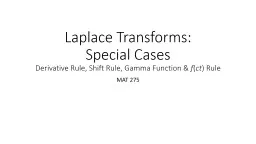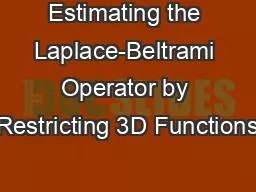PPT-Laplace Transforms: Special Cases
Author : min-jolicoeur | Published Date : 2018-10-29
Derivative Rule Shift Rule Gamma Function amp f ct Rule MAT 275 Derivative Rule If then Proof Using the definition of the Laplace Transform we have Differentiate
Presentation Embed Code
Download Presentation
Download Presentation The PPT/PDF document "Laplace Transforms: Special Cases" is the property of its rightful owner. Permission is granted to download and print the materials on this website for personal, non-commercial use only, and to display it on your personal computer provided you do not modify the materials and that you retain all copyright notices contained in the materials. By downloading content from our website, you accept the terms of this agreement.
Laplace Transforms: Special Cases: Transcript
Download Rules Of Document
"Laplace Transforms: Special Cases"The content belongs to its owner. You may download and print it for personal use, without modification, and keep all copyright notices. By downloading, you agree to these terms.
Related Documents














